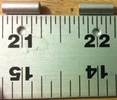


random user submitted photo
Battery and Alternator schematic
2 posts
• Page 1 of 1
Battery and Alternator schematic
Hello all!
I'm working on the details of my Onex schematic in small bits. Drawn here is the battery and alternator portion of the circuit. I'll add the engine ignition circuits next, and then the main bus and beyond. I'm looking for general feedback. I have a few specific questions also.
1. Should the regulator contactor coil be powered from Vout of the regulator (as drawn), or the battery? Does this matter?
2. I have the master configured as off-batt-both. Is that reasonable, or should I use separate switches so I can also isolate the battery and run from the alternator only?
3. I'm not really sure of how the alternator/regulator circuit may fail and where to place the contactor.
a) as drawn, the everything is protected from a failure of either (alternator or regulator), but I've heard the alternator can melt down the regulator and do some extraneous physical damage.
b) if the contactor is instead between the alternator and regulator, a meltdown could be prevented. In that case, however a failed regulator might short the battery to ground. Can that happen?
I'm working on the details of my Onex schematic in small bits. Drawn here is the battery and alternator portion of the circuit. I'll add the engine ignition circuits next, and then the main bus and beyond. I'm looking for general feedback. I have a few specific questions also.
1. Should the regulator contactor coil be powered from Vout of the regulator (as drawn), or the battery? Does this matter?
2. I have the master configured as off-batt-both. Is that reasonable, or should I use separate switches so I can also isolate the battery and run from the alternator only?
3. I'm not really sure of how the alternator/regulator circuit may fail and where to place the contactor.
a) as drawn, the everything is protected from a failure of either (alternator or regulator), but I've heard the alternator can melt down the regulator and do some extraneous physical damage.
b) if the contactor is instead between the alternator and regulator, a meltdown could be prevented. In that case, however a failed regulator might short the battery to ground. Can that happen?
- gr8jab
- Posts: 4
- Joined: Tue Oct 20, 2020 5:39 pm
Re: Battery and Alternator schematic
gr8jab,
Here are a few thoughts in response to your questions.
Power from the battery. This is important if you change the location of the relay (see 3, below) to the alternator AC line.
The way you have it is fine (Off - BAT - BAT+ALT). There's no practical reason to run battery off and alternator on.
The most common regulator failure is that is simply stops outputting DC voltage (from a fault that develops internally to the regulator). You'll notice this as low bus voltage, and it will slowly drop as the battery depletes itself. This is why every plane should include active monitoring of low bus voltage - it tells you nearly everything you care about (e.g is the alternator working, and how "full" is the battery). If you have an electrically dependent engine (such as EFI), it's even more important.
Other failures can happen, but short of something coming loose inside the alternator and tearing up the coils these are not common or likely. Cooling the regulator can help (blast tube, mounted to a good heat sink or in a location that gets good airflow), and you'll want good crimps with tight connectors on all electrical wires to keep the corrosion out. This is actually one pretty common way regulators fail is to have the output line get a little loose inside the connector, develop a little corrosion or back smutz inside, then the joint resistance goes up and the regulator overheats and dies.
The relay should break contact of one AC line coming from the alternator. This way the alternator goes stone-cold-dead when the relay opens, and won't continue to make AC current that the regulator has to absorb. In just the right scenario the regulator can overheat and melt down unless you stop pumping AC current into it. This is rare, but it's happened twice in the years I can think of.
Regulators don't fail internally were the output is shorted to ground. If you're concerned about this you can add protection to the output wire (e.g. between the voltage regulator output and the battery) using a fuse or fusible link. These will need to be carefully thought out though or you'll simply add another possible point of failure to your system.
Lastly, there are a lot of good ideas on this thread (viewtopic.php?f=65&t=5583), and you can pick and choose from them to get a jump on your diagrams.
Jeff
Here are a few thoughts in response to your questions.
gr8jab wrote:1. Should the regulator contactor coil be powered from Vout of the regulator (as drawn), or the battery? Does this matter?
Power from the battery. This is important if you change the location of the relay (see 3, below) to the alternator AC line.
gr8jab wrote:2. I have the master configured as off-batt-both. Is that reasonable, or should I use separate switches so I can also isolate the battery and run from the alternator only?
The way you have it is fine (Off - BAT - BAT+ALT). There's no practical reason to run battery off and alternator on.
gr8jab wrote:3. I'm not really sure of how the alternator/regulator circuit may fail and where to place the contactor.
The most common regulator failure is that is simply stops outputting DC voltage (from a fault that develops internally to the regulator). You'll notice this as low bus voltage, and it will slowly drop as the battery depletes itself. This is why every plane should include active monitoring of low bus voltage - it tells you nearly everything you care about (e.g is the alternator working, and how "full" is the battery). If you have an electrically dependent engine (such as EFI), it's even more important.
Other failures can happen, but short of something coming loose inside the alternator and tearing up the coils these are not common or likely. Cooling the regulator can help (blast tube, mounted to a good heat sink or in a location that gets good airflow), and you'll want good crimps with tight connectors on all electrical wires to keep the corrosion out. This is actually one pretty common way regulators fail is to have the output line get a little loose inside the connector, develop a little corrosion or back smutz inside, then the joint resistance goes up and the regulator overheats and dies.
gr8jab wrote:a) as drawn, the everything is protected from a failure of either (alternator or regulator), but I've heard the alternator can melt down the regulator and do some extraneous physical damage.
The relay should break contact of one AC line coming from the alternator. This way the alternator goes stone-cold-dead when the relay opens, and won't continue to make AC current that the regulator has to absorb. In just the right scenario the regulator can overheat and melt down unless you stop pumping AC current into it. This is rare, but it's happened twice in the years I can think of.
gr8jab wrote:b) if the contactor is instead between the alternator and regulator, a meltdown could be prevented. In that case, however a failed regulator might short the battery to ground. Can that happen?
Regulators don't fail internally were the output is shorted to ground. If you're concerned about this you can add protection to the output wire (e.g. between the voltage regulator output and the battery) using a fuse or fusible link. These will need to be carefully thought out though or you'll simply add another possible point of failure to your system.
Lastly, there are a lot of good ideas on this thread (viewtopic.php?f=65&t=5583), and you can pick and choose from them to get a jump on your diagrams.
Jeff
- sonex1374
- Posts: 605
- Joined: Thu Mar 27, 2014 1:02 am
2 posts
• Page 1 of 1
Who is online
Users browsing this forum: No registered users and 7 guests







